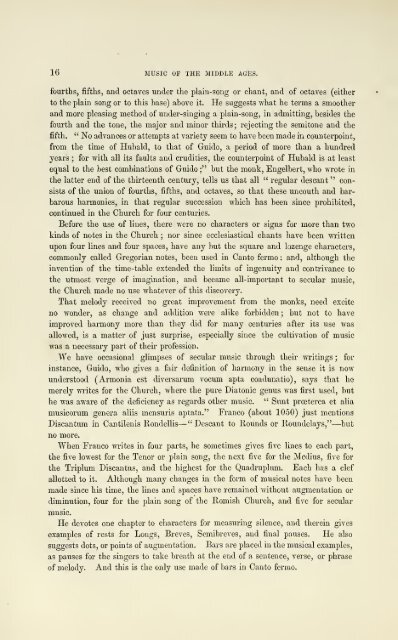Popular music of the olden time. A collection of ancient songs ...
Popular music of the olden time. A collection of ancient songs ...
Popular music of the olden time. A collection of ancient songs ...
Create successful ePaper yourself
Turn your PDF publications into a flip-book with our unique Google optimized e-Paper software.
16 MUSIC OF THE MIDDLE AGES.<br />
fourths, fifths, and octaves under <strong>the</strong> plain-song or chant, and <strong>of</strong> octaves (ei<strong>the</strong>r<br />
to <strong>the</strong> plain song or to this base) above it. He suggests what he terms a smoo<strong>the</strong>r<br />
and more pleasing method <strong>of</strong> under-singing a plain-song, in admitting, besides <strong>the</strong><br />
fourth and <strong>the</strong> tone, <strong>the</strong> major and minor thirds ; rejecting <strong>the</strong> semitone and <strong>the</strong><br />
fifth. " No advances or attempts at variety seem to have been made in counterpoint,<br />
from <strong>the</strong> <strong>time</strong> <strong>of</strong> Hubald, to that <strong>of</strong> Guido, a period <strong>of</strong> more than a hundred<br />
years ;<br />
for with all its faults and crudities, <strong>the</strong> counterpoint <strong>of</strong> Hubald is at least<br />
equal to <strong>the</strong> best combinations <strong>of</strong> Guido ;" but <strong>the</strong> monk, Engelbert, who wrote in<br />
<strong>the</strong> latter end <strong>of</strong> <strong>the</strong> thirteenth century, tells us that all " regular descant " consists<br />
<strong>of</strong> <strong>the</strong> union <strong>of</strong> fourths, fifths, and octaves, so that <strong>the</strong>se uncouth and barbarous<br />
hai-monies, in that regular succession which has been since prohibited,<br />
continued in <strong>the</strong> Church for four centuries.<br />
Before <strong>the</strong> use <strong>of</strong> lines, <strong>the</strong>re were no characters or signs for more than two<br />
kinds <strong>of</strong> notes in <strong>the</strong> Church ; nor since ecclesiastical chants have been wiitten<br />
upon four lines and four spaces, have any but <strong>the</strong> square and lozenge characters,<br />
commonly called Gregorian notes, been used in Canto fermo : and, although <strong>the</strong><br />
invention <strong>of</strong> <strong>the</strong> <strong>time</strong>-table extended <strong>the</strong> limits <strong>of</strong> ingenuity and contrivance to<br />
<strong>the</strong> utmost verge <strong>of</strong> imagination, and became all-important to secular <strong>music</strong>,<br />
<strong>the</strong> Church made no use whatever <strong>of</strong> this discovery.<br />
That melody received no great improvement from <strong>the</strong> monks, need excite<br />
no wonder, as change and addition were alike forbidden; but not to have<br />
improved harmony more than <strong>the</strong>y did for many centuries after its use was<br />
allowed, is a matter <strong>of</strong> just surprise, especially since <strong>the</strong> cultivation <strong>of</strong> <strong>music</strong><br />
was a necessary part <strong>of</strong> <strong>the</strong>ir pr<strong>of</strong>ession.<br />
We have occasional glimpses <strong>of</strong> secular <strong>music</strong> through <strong>the</strong>n* writings ; for<br />
instance, Guido, who gives a fair definition <strong>of</strong> harmony in <strong>the</strong> sense it is now<br />
understood (Armenia est diversarum vocum apta coadunatio), says that he<br />
merely writes for <strong>the</strong> Church, where <strong>the</strong> pure Diatonic genus was first used, but<br />
he was aware <strong>of</strong> <strong>the</strong> deficiency as regards o<strong>the</strong>r <strong>music</strong>. " Sunt prceterea et alia<br />
<strong>music</strong>orum genera aliis mensuris aptata." Franco (about 1050) just mentions<br />
Discantum in Cantilenis Rondellis— " Descant to Rounds or Roundelays,"—but<br />
no more.<br />
When Franco writes in four parts, he some<strong>time</strong>s gives five lines to each part,<br />
<strong>the</strong> five lowest for <strong>the</strong> Tenor or plain song, <strong>the</strong> next five<br />
for <strong>the</strong> Medius, five for<br />
<strong>the</strong> Triplum Discantus, and <strong>the</strong> highest for <strong>the</strong> Quadruplum. Each has a clef<br />
allotted to it.<br />
Although many changes in <strong>the</strong> form <strong>of</strong> <strong>music</strong>al notes have been<br />
made since his <strong>time</strong>, <strong>the</strong> lines and spaces have remained without augmentation or<br />
diminution, four for <strong>the</strong> plain song <strong>of</strong> <strong>the</strong> Romish Church, and five for secular<br />
<strong>music</strong>.<br />
He devotes one chapter to<br />
characters for measuring silence, and <strong>the</strong>rein gives<br />
examples <strong>of</strong> rests for Longs, Breves, Semibreves, and final pauses. He also<br />
suggests dots, or points <strong>of</strong> augmentation.<br />
Bars are placed in <strong>the</strong> <strong>music</strong>al examples,<br />
as pauses for <strong>the</strong> singers to take breath at <strong>the</strong> end <strong>of</strong> a sentence, verse, or phrase<br />
<strong>of</strong> melody. And this is <strong>the</strong> only use made <strong>of</strong> bars in Canto fei'mo.

















